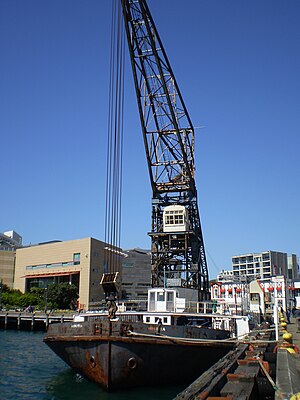 Hikitia at the Taranaki Street wharf
| |
| History | |
|---|---|
| Name | Hikitia |
| Owner | Maritime Heritage Trust of Wellington |
| Port of registry | Wellington |
| Builder | Fleming & Ferguson, Paisley, Scotland[1] |
| Yard number | 486[1] |
| Launched | 15 April 1926[1] |
| Maiden voyage | 29 September 1926[2] |
| Identification | IMO number: 5150393 |
| Status | Operational |
| General characteristics | |
| Tonnage | 746 GRT[1] |
| Displacement | 926 tonnes |
| Length | 160.1 ft (48.8 m)[1] |
| Beam | 52.3 ft (15.9 m)[1] |
| Draught | 7 ft (2.1 m)[2] |
| Installed power | steam engines originally fed by coal-fired Scotch boilers, later replaced in 1963 by oil-fired boilers and then by small modern package boilers.[citation needed] |
| Propulsion | twin screw[1] |
| Speed | about 9 kn (16.7 km/h)[2] |
Hikitia is a self-propelled floating steam crane in Wellington Harbour, New Zealand. She is thought to be the only working steam crane of her type in the world.
She is also the sister ship to the Rapaki, formerly of the Port of Lyttelton, which was put on display at the New Zealand Maritime Museum after being taken out of service, and then scrapped in January 2019. Some parts from Rapaki were given to Hikitia.[3]
- ^ a b c d e f g Cameron, Stuart; Allen, Bruce; Robinson, George. "Hikitia". Clyde-built Database. Archived from the original on 27 June 2007. Retrieved 23 May 2011.
{{cite web}}: CS1 maint: unfit URL (link) - ^ a b c ""Hikitia" --- to Lift - Wellington's Floating Crane - successful voyage completed". Evening Post. 21 December 1926 – via Papers Past.
- ^ Cite error: The named reference
:0was invoked but never defined (see the help page).